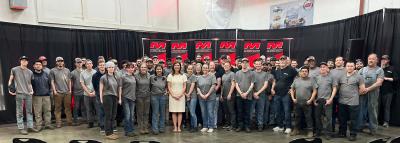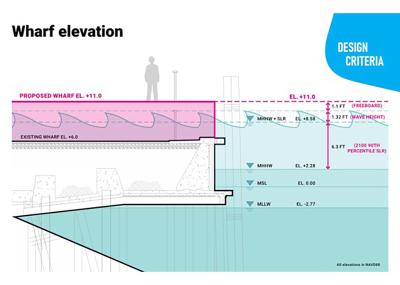In May, after three and a half years of work, the Indianapolis Museum of Art (IMA) will unveil a new work of art: a remodeled and expanded version of itself.
The three major objectives under this $220 million plan include: building and strengthening the permanent art collections with an $80 million art acquisition fund; enhancing the educational and outreach programming with a $30 million new operating endowment fund; and facilities development and enhancement with a $109 million initiatives fund, out of which comes the $74 million expansion and renovation project.
The expansion and renovation project, begun in the fall of 2001, will add 164,000 sq. ft. (15,236 sq m) of space to the facility and renovate 90,000 sq. ft. (8,361 sq m) of existing space on the museum grounds. In addition, 90,912 sq. ft. (8,446 sq m) of new underground parking will be added.
New galleries in three new wings will add 50 percent more gallery space; new landscaping, gardens and the development of the 100-acre Virginia B. Fairbanks Art & Nature Park west of the main IMA campus; a 300 percent increase in educational studios for art classes; and dining spaces –– including fine dining, casual eating spaces and a 500-person banquet hall –– will be included in the expanded space, according to Nancy Hasslebring, the museum’s administrator of business operations.
“Almost every single area of the museum will be affected by this expansion,” said Hasslebring.
The first phase, restoration of the Oldfields-Lilly House and Gardens (former 26-acre estate of the late Indianapolis businessman and philanthropist J.K. Lilly Jr.), was completed in 2002. The Virginia B. Fairbanks Art & Nature Park opened in 2004, although development will continue for a decade.
Walking paths punctuated by outdoor sculpture areas wind through wooded land featuring a scenic 30-acre lake as its centerpiece.
But the IMA initiative is more than just a building project; in addition to creating diverse new interior and exterior spaces to enhance presentation of its growing collections, it includes further supplementing the Museum’s collections and programming.
The building’s last major expansion occurred in 1988 and enabled the Museum to feature major special exhibitions. Since then, the Museum’s permanent collections have grown by 20 percent with the acquisition of 7,000 new objects. Increasingly gallery space by 50 percent will allow more of its collection to be on display.
The new Gallery Pavilion, built in front of the former main entrance, adds 44,000 sq. ft. (4,088 sq m) of display space on three floors. Its interior atrium with escalator access will improve traffic flow.
On the main level, two new restaurants add to the Museum’s attractions. Both the fine dining restaurant that seats 80 and the self-service café that seats 140 feature views of the Sutphin Fountain garden. An al fresco area will add seating for an additional 50 when weather permits.
Although the Indianapolis Civic Theatre, which has been on Museum grounds since 1973, moved to a new location, a new Special Events Pavilion offers a venue for special events and public programs. The one-story facility seats 500 in its main dining room. Its reception lobby accommodates 300.
Planned chaos
Browning Day Mullins Dierdorf Architects’ executive vice president Jonathan R. Hess, who also designed the city’s Eiteljorg Museum, served as lead designer.
“We were contacted back in 1997 to assist the Museum’s Board of Trustees with its strategic planning,” said Hess. Two years later, the company began working on the design of the new buildings.
Selected to perform pre-construction services including establishing a budget and schedule, Indianapolis-based F.A. Wilhelm priced elements of the project so the board of trustees, curators and staff could determine where to allocate funds. While the curators hoped for more gallery space, the board wanted to expand the Museum’s capacity and functionality.
The staff wished for upgraded building systems and landscaping. Wilhelm prepared a line-item budget, with detailed explanations of the impact of each choice. Steve Ernest, IMA’s director of building services, said the groups considered the advancement of the arts and facility maintenance as well as needs and wish lists before making the final decisions.
To make up for lost time in the lengthy decision-making process, Wilhelm guaranteed a fixed price and agreed to start work before the final documents were complete.
“We started construction activities while the design reviews of the building’s structural, mechanical and electrical components were on-going,” explained Chris French, operations manager for F.A. Wilhelm.
As the project progressed, new drawings and ideas were presented to Wilhelm for estimates. Next, the construction schedule had to be revamped to work around Museum events. The subsequent challenge was working within the constraints of the existing structural and mechanical systems.
“We encountered many design issues,” confirmed Hess.
The mechanical systems were in desperate need of upgrading. Although addressing the problem wrecked the budget, the new mechanical systems installed by Circle Design, Havel Brothers and Trane will reduce annual energy costs by more than $60,000, alleviating the sticker shock.
Oval entry signifies new arrival
The expansion is intended to significantly improve visitor access and amenities, in addition to increasing gallery space. Components of the expansion include the Oval Entry Pavilion, the Gallery Pavilion and the Special Events Pavilion.
As the primary point of visitor access, the stunning Oval Entry Pavilion will set the tone for the Museum experience. Tim McFarlane, of Dewhurst McFarlane and Partners of London, assisted with the design and construction of the 54-ft. (16.5 m) three-story, glass-enclosed “jewel box” oval structure, whose transparency permits views of the gardens and relocated Sutphin Fountain, which formerly stood center stage at the bottom of the marble entry steps.
Budgetary problems quickly arose with the original plan.
“We had a guaranteed maximum budget number on the entry pavilion, and our budget exceeded that number,” reported Hess.
To reduce costs, architects re-engineered the entryway, working closely with Milwaukee-based design-build contractor Mero Structures Inc., a company specializing in large glass structures.
The large expanse of glass imposed demanding specifications for glass size and fabrication. Hess credits Buddy Combs, a “researcher at heart” who worked with the glass supplier to develop an insulated glass unit that met the museum’s criteria.
The insulated glass structure consists of a unique assembly. Typically, the insulated glass units forming the structure would feature two layers of .375-in. (.953 cm) glass on each side of a .5-in. (1.27 cm) air space.
Hess’ original design called for stainless steel brackets to brace these standard insulated 10-ft. (3.1 m) units at the third points.
“We had a stiffener at 3 feet and 6 feet on the glass,” Hess confirmed. But when the designers thickened the glass, the need for the stainless steel stiffening brackets was eliminated.
The redesigned structure will consist of the two layers of .375-in. (.953 cm) glass laminated together, with the .5-in. (1.27 cm) air space and an additional .5-in. layer of glass.
Using an in-house steel fabricating group also reduced costs.
“These guys are really smart with steel,” said Doug Curts, design phase manager. “That’s the biggest component of it.”
Wilhelm also relied on Mero to engineer and build the horizontal elliptical stainless steel truss support system and all-glass oval entry pavilion and vestibule.
Four 152-ft. (46.3 m) horizontal elliptical arches are spaced over a height of four stories, with 7,000 sq. ft. (650.3 sq m) of insulated glass. The system is supported by the four stainless steel elliptical trusses with tension rods from the building structure.
The trusses will also support aluminum shading devices installed horizontally to minimize visual obstruction and maximize energy efficiency. Timm Walker, regional sales manager for Mero, says the 50-ton (45 t) structure was designed to look as transparent as possible.
Because Mero is the largest integrator of glass and steel in the U.S., Walker said it was imperative that the same company oversee the engineering and installation of glass and steel.
“These systems require very tight tolerances,” Walker added.
Open for business
One of the biggest challenges facing general contractor F.A. Wilhelm was the necessity of keeping the museum open during much of construction, although the Museum is closed from January to May 2005 in order to finish detail work and install collections.
Hasselbring said the Museum staff worked very closely with Wilhelm on logistics, scattering departments into temporary offices as construction progressed.
IMA’s director of building services, Steve Ernst said, “We haven’t missed any deliveries or had any problems getting people in or out of the property for the past two years, and haven’t had to close down due to any problems.”
Replacing water and storm lines and the old mechanical system remained a behind-the-scenes orchestration that never intruded upon Museum visitors, thanks to six months of planning.
Because the Museum’s entrance was originally on the east side –– which had to be demolished to allow the eastward expansion –– the first order of business involved creating a temporary entrance through the Hulman Pavilion on the Museum’s south side.
Once that was accomplished, demolition of the main east entrance, plaza and Krannert Pavilion could begin. But because the stairs, consisting of reinforced concrete and granite, provided lateral support for the main building, additional bracing had to be installed before demolition.
Next, Wilhelm demolished walls and ceilings in security areas, art areas and art storage areas to expose existing steel beams so bracing could be attached.
The new site plan shifts the Museum’s orientation from the west overlooking the White River to the east in order to tie it to the city grid and make it a more visible part of the community. The main access shifts from 38th Street to Michigan Road, with a tree-lined allée drawing visitors in toward the relocated Sutphin Fountain, surrounded by new garden spaces, and the Oval Entry.
Finishing touches
The dramatic Oval Entry offers amenities such as two new restaurants, a new education gallery, a new, larger Museum store, ticketing center and a 250-space underground parking garage.
Under the renovation plan, the former parking structure and fountain level became library, photography and print storage, security and exhibit space. Its elimination necessitated a new structure, so a separate underground structure was incorporated.
Doug May, Wilhelm’s project superintendent, explained that the garage consists of reinforced concrete that won’t include post-tensioning. The roof consists of drop heads with a 15-in. (38 cm) slab.
“The foundation walls didn’t have to be shored,” May added.
Noting the Museum’s legacy of park-like setting, Hess believes it was important to maintain the esthetic by building the parking facility underground –– and out of sight.
After numerous studies, “everyone quickly understood we would be consuming the site with parking if we didn’t commit to the underground parking garage,” May said.
All perimeter grounds will be newly landscaped. A lightweight rooftop planting medium on top of the parking structure allowed for the installation of trees, plants and sod without adding substantial weight to the garage.
The material is about half the weight of dirt, and provides improved drainage while still retaining moisture for plantings. To assist in keeping the budget in line, Irving Materials, the Greenfield, IN-company providing concrete for the project, produced the special planting medium for 75 percent of the cost a firm in Georgia charges.
In January most of the heavy equipment left: gone are the Takeuchi TL 150, Manitowoc 230-ton (207 t) crawler crane, 10,000-lb. (4,536 kg) Lulls, and the handful of Grove 50-ton (45 t) cranes and JLG aerial boom lifts while the IMA is closed to the public for the final construction phase of interior spaces.
It will reopen May 6 to show a reveal a new masterpiece to the American Association of Museums National Conference.
This story also appears on Crane Equipment Guide.
Today's top stories















